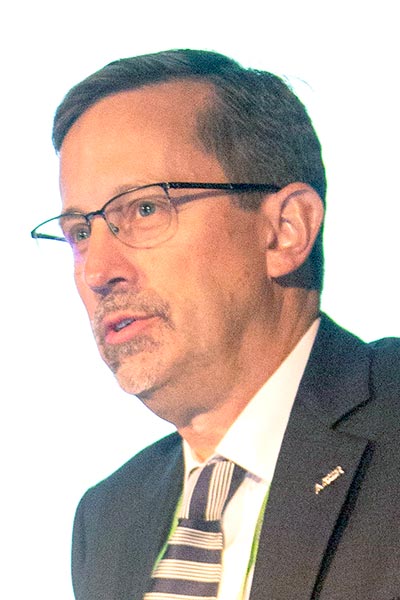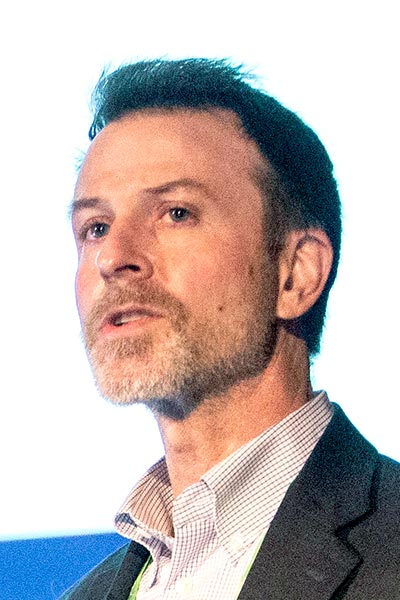Presidential Select Symposium examines links between aging, stress, and cancer
AACR Past President David A. Tuveson, MD, PhD, FAACR, organized a special symposium at the AACR Annual Meeting 2022 that examined potential mechanisms underlying the relationship between stress and cancer, and how premature tissue aging may participate in an intrinsic and/or extrinsic fashion.

The session, Presidential Select Symposium: Aging, Stress, and Cancer, was originally presented on Monday, April 11, and can be viewed on the virtual platform by registered meeting participants through July 13, 2022.
“Aging is well-associated with cancer, but there are people who develop cancer before their time,” said Tuveson, of Cold Spring Harbor Laboratory Cancer Center, who introduced the symposium’s four presenters.
“There are young people who get cancer,” he continued. “They may not come from families with cancer, but they may show signs of stress like obesity or poverty. Poverty doesn’t cause disease, but living poorly can cause stress. There are people who are poor who live long and well and those who do not. The hypothesis is that stress causes cancer because stress causes premature aging in cells throughout the body. Cancer is not all about ancestry.”
The symposium’s first speaker, Electra D. Paskett, PhD, of Ohio State University, explored data linking cancer with social stresses—both constant stresses such as socioeconomic status and episodic or defined stresses such as the COVID-19 pandemic.

“Where you live describes factors such as socioeconomic status, historical patterns of oppression, access to health care, discrimination, and violence,” she said. “All of these factors contribute to cancer. Where you live is the new vital sign.”
The research community has been slow to accept associations between stress and cancer, she added. But newer approaches are confirming the link, supported by clinical studies that are identifying biochemical mechanisms.
Epidemiological studies in Holocaust survivors found an increased risk of cancer for all sites, ranging with hazard ratios of 1.71 to 3.50, Paskett noted, and the Dutch “hunger winter” of 1944-45 increased the risk of breast cancer in survivors by nearly 50 percent.
Constant events such as discrimination, violence, and socioeconomic status, sometimes referred to as lived experiences, have similar consequences. Stress induces central nervous system responses that activate the autonomic nervous system and the hypothalamic-pituitary-adrenal axis, she explained. Stress hormones modulate multiple components of the tumor microenvironment (TME), including the promotion of tumor-cell growth, migration, and invasive capacity, angiogenesis, activation of oncogenic viruses, and alterations in immune function.
Downstream effects create a more permissive environment for tumor initiation, growth, and progression through modulation of corticotropin-releasing factor, interleukin 6, matrix metalloproteinase, and vascular endothelial growth factor (VEGF).
“Stress impacts across the cancer continuum, from cancer development to survivorship or supportive care,” Paskett said. “In both mouse models and in urban Chicago, the built environment can foster vigilance and increase cancer risk, which accounts for disparities in breast cancer mortality in Chicago between Black and White women. Similar community-based stress factors drive elevated rates of HPV (human papillomavirus) infection and cervical cancer in Appalachia.”

Sleep disruption, a stressor commonly associated with shift work and noisy, crowded living environments, has a clear mechanistic link with prostate cancer, added Ayesha Shafi, PhD, of Uniformed Services University. Poor, insufficient, or interrupted sleep disrupts the circadian clock, which is associated with increased incidence of breast, lung, and prostate cancer worldwide.
“The circadian clock regulates multiple processes to maintain homeostasis,” she said. “Once disrupted, it can impact a number of pathways leading to cancer.”
Disrupted circadian rhythm downgrades cellular energetics, sustains proliferative cell signaling, induces angiogenesis, activates tumor invasion and metastasis, enables replicative immortality, promotes inflammation, and has other pro-tumor effects, Shafi explained. Some of those effects and pathways can affect prostate cancer progression.
The circadian cryptochrome, CRY1, is an evolutionarily conserved transcriptional coregulator that regulates DNA repair. Circadian disruption disrupts CRY1, which modulates homologous recombination in DNA repair in a rhythmic pattern. Disrupting the normal rhythmic expression pattern can disrupt DNA damage repair.
CRY1 is also induced by androgen receptor activity in hormone-sensitive prostate cancer, Shafi said. Increased expression of CRY1 can stimulate disease progression. Men with prostate cancer and high levels of CRY1 have much shorter metastatic free survival and poorer outcomes compared to men with low CRY1.

The effects of sleep disruption and other stressors on T-cell activity is less well understood. Senescence and exhaustion are distinct processes. T cells clearly mediate responses to checkpoint blockade and to tumor-infiltrating lymphocyte, chimeric antigen receptor T cells, and engineered TCR-T cell therapies, said E. John Wherry, PhD, of University of Pennsylvania Perelman School of Medicine. What is less clear is why so many patients lack sustained response.
“We have a limited understanding of why some patient T cells respond well and others do not,” Wherry said. “Why are we not doing better?”
Senescent human T cells are CD45RA+, CD37-, CD38-, and CD57+, Wherry noted. Senescent T cells are often cytotoxic and inflammatory with short telomeres and low proliferative capacity, and express NK receptors. They also tend to be PD-1 intermediate.
Robust DNA damage repair is critical for durable T-cell responses, Wherry said. Successful checkpoint blockade is associated with high DNA damage repair in proliferating T cells. Both findings have therapeutic implications.
“We can’t predict DNA damage in immune cells during cancer therapy,” Wherry said. “Chemotherapy and radiation affect the immune cells that are important to support DNA repair.”

Cancer is largely a disease of aging, noted Ashani T. Weeraratna, PhD, of Johns Hopkins University. Of every 100 people diagnosed with cancer, 89 percent will be 50 or older, she said. Changes to the TME are a factor.
“No tumor is an island,” Weeraratna said. “It’s part of larger tissues and its microenvironment. Aging affects many tumor progression factors, including the TME.”
In mice, as in humans, the TME changes with age. Tumors metastasize more efficiently in older mice, at least in part due to age-related changes in fibroblasts, Weeraratna explained.
Treatment effect can also vary by age. An analysis of 1,000 melanoma patients treated with avastin found that younger patients responded nearly 30 percent better compared to patients 65 and older, she said.
In mice, SFRP2 supersedes VEGF as an angiogenic driver during aging. SFRP2 increases with age and VEGF decreases. SFRP2 also inhibits the efficacy of anti-VEGF. It may be more effective to target SFRP2 than VEGF in older patients to inhibit angiogenesis, Weeraratna said.
Aged fibroblasts also affect treatment. In the skin and other tissues, endothelial cells are surrounded by less collagen in older individuals.
Sex matters, too. Female dermal fibroblasts proliferate more slowly than those in males and undergo earlier replicative senescence. Further, the aging male TME increases resistance to targeted cancer therapy compared to the aging female TME.
“There are multiple cancer-related changes that come with aging,” Weeraratna said. “Age is a confounding factor. We need to consider the aging microenvironment when treating patients and in designing preclinical and clinical studies.”
More from the AACR Annual Meeting 2025
View a photo gallery of scenes from Chicago, continue the conversation on social media using the hashtag #AACR25, and read more coverage in AACR Annual Meeting News.

